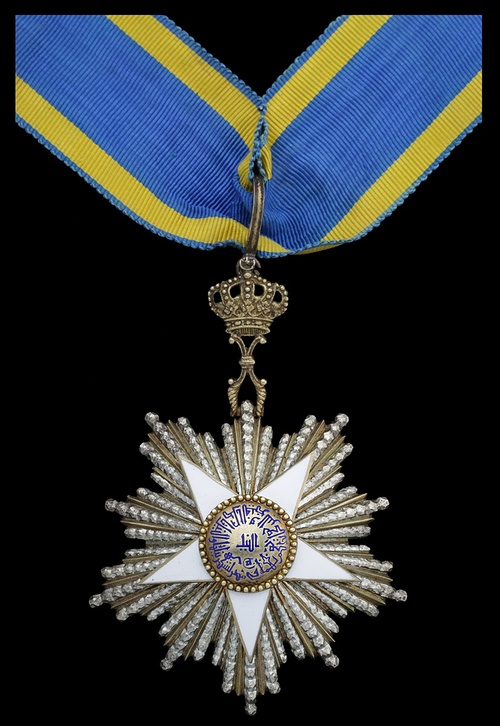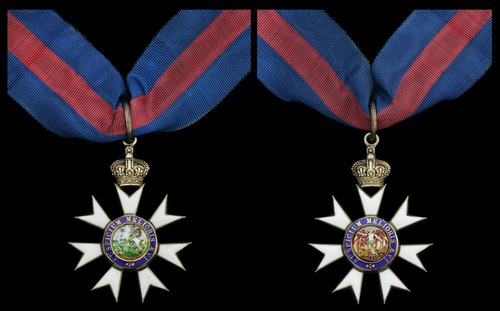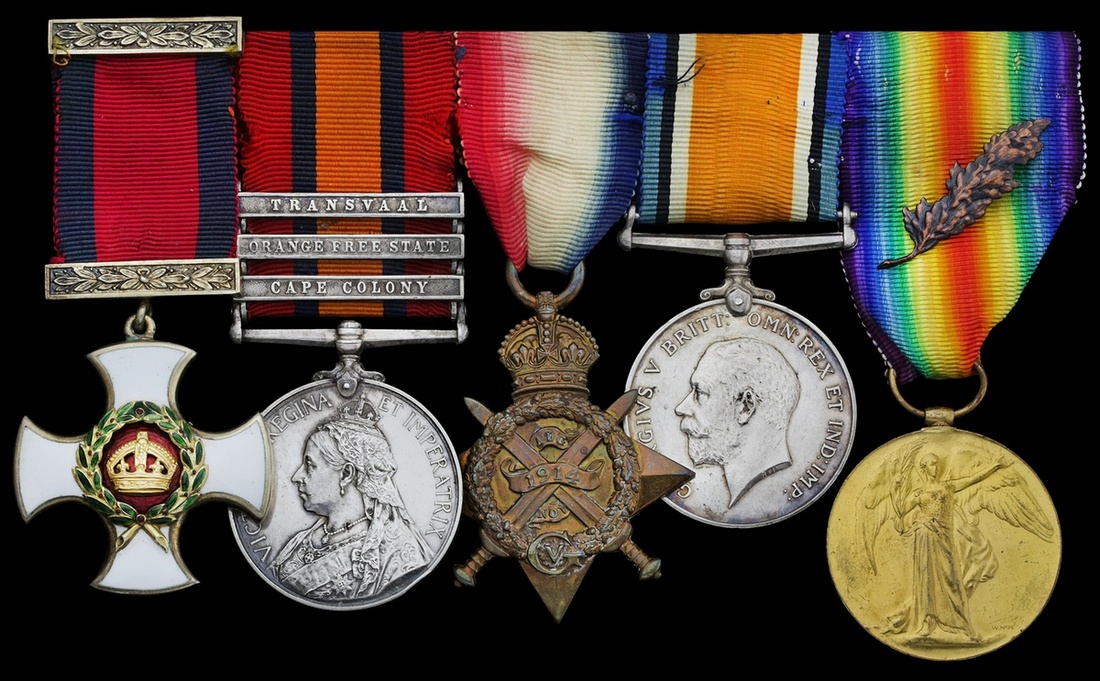Auction: 20001 - Orders, Decorations and Medals - conducted behind closed doors
Lot: 655
A fine Great War C.M.G., D.S.O. group of seven awarded to Colonel O. W. Richards, Royal Army Medical Corps, late Army Medical Service, who pioneered the application of surgery to abdominal wounds and requested his own Casualty Clearing Station be moved closer to the front line so as to reduce the evacuation time of his patients
The Most Distinguished Order of St. Michael and St. George, C.M.G., Companion's neck Badge, silver-gilt and enamel; Distinguished Service Order, G.V.R., silver-gilt and enamel with integral top riband bar; Queen's South Africa 1899-1902, 3 clasps, Cape Colony, Orange Free State, Transvaal (O. Richards, Civ: Surgeon. I. Y. Hosp:); 1914 Star (Lieut: O. Richards. R.A.M.C.); British War and Victory Medals (Col. O. Richards.); Egypt, Kingdom, Order of the Nile, Second Class set of Insignia, comprising neck Badge and breast Star by Lattes, silver, silver-gilt and enamel, maker's name to reverse, the second to sixth mounted as worn, D.S.O. with depressed centre, very fine, housed in a fitted Garrard & Co. Ltd case (7)
C.M.G. London Gazette 3 June 1918.
D.S.O. London Gazette 23 June 1915.
Order of the Nile London Gazette 13 September 1921:
'For services to medical education.'
Owen William Richards was born on 30 September 1873 at Isleworth Vicarage, the younger son of the Reverend H. W. P. Richards, Prebendary of St. Paul's Cathedral, London. Home educated until the age of 13, Richards won a King's Scholarship to Eton College and subsequently obtained a 1st Class B.A. (Honours) in physiology at New College, Oxford. Elected to a Winchester Fellowship in October 1898, Richards became a student at Guy's Hospital, graduating in 1902, proceeding M.D. in 1905 and taking the F.R.C.S. in the same year. His studies were interrupted for a time by the South African War, when he served as a dresser (Queen's Medal & 3 clasps).
Appointed Professor of Clinical Surgery at the School of Medicine in Cairo in 1905, Richards was accustomed to ride out to the military hospital of the Egyptian Army at Abbassia. He also 'employed his leisure hours in practising operations on the intestines of a cow in order to perfect his technique' (The British Medical Journal, refers). For the next nine years Richards did yeoman service in Cairo before retiring from the Egyptian service and taking a commission in the Royal Army Medical Corps at the outbreak of hostilities.
Posted to Versailles as subaltern, Richards was taken under the wing of Sir Arthur Thomas Sloggett, K.C.B., K.C.M.G., K.C.V.O., who served as Director-General of the Army Medical Services and British Armies in the Field. Under Sloggett's guidance, Richards was promoted Captain and became a pioneer of abdominal surgery, publishing The pathology and treatment of gunshot wounds of the small intestine in 1915.
Surgical opinion pre-1914
The practise of surgery in a military setting has always been difficult. There is not only the problem of inadequate or limited resources but in addition, the nature of the injuries can differ markedly from those found in civil practise. One of the most famous surgeons of the late Victorian era, Sir William MacCormack wrote in the report of his experiences during the Franco-Prussian War of 1870-71:
'Of penetrating wounds of the abdomen we saw but few, and the subjects of these died rapidly from peritonitis and shock.'
At that time the medical profession almost entirely shared MacCormack's pessimism regarding the value of operating on abdominal wounds, and from a table of injuries treated it seems that nothing was ever done for abdominal cases (Abdominal Surgery in the War - the early story, by J. C. D. Bennett, refers). However there were surgeons who felt that more could be done, none moreso than James Marion Sims who took over command of the Anglo-American Ambulance from MacCormack and is remembered today for popularising the practice of surgical intervention for gunshot wounds at a time when laparotomy was in its infancy.
Despite medical advancement by the interventionists led by French Surgeon Reclus, the British remained firmly against operating on intestinal wounds, this view reinforced by the appointment of MacCormack as Consulting Surgeon to the South African Field Force. According to Bennett, 'his word was law'. During his time in South Africa from 4 November 1899-26 April 1900, MacCormack formed the opinion that:
'In this [the South African] war, a man wounded in the abdomen dies if he is operated on and remains alive if he is left in peace.'
This policy of non-intervention was adopted by the British Army and became known as 'MacCormack's Aphorism'. It was adopted during the Russo-Japanese War of 1904-05 and was reinforced by the Russian Imperial Military Academy of Medicine.
Whilst statistics remained limited and records poor, this was the policy which largely held out in the years leading to the Great War, indeed Surgeon General Stevenson in the Official History of the War in South Africa 1899-1902, was only able to collect 207 cases of abdominal wounds, of whom 26 received laparotomies with 18 deaths (a mortality rate of 62.2%). However, the voice of dissenters led by Vera Gedroits who introduced early operations in an ambulance train in Manchuria, was growing, their argument becoming louder as mobile warfare looked set to evolve into a more static conflict which allowed for the construction of medical facilities near the point of need.
Great War
In 1914, records show that initial surgical practise was expectant; operative intervention simply could not be carried out under the prevailing conditions to a level where the chances of a man's survival increased with surgery. However, with the development of static lines and trench warfare, intervention surgery became a realistic option which was seized upon by Sloggett and Richards, together with their French and Belgian equivalents. Professor Tuffier wrote of the French experience that until 1915 it was expectant because conditions dictated this, but he had however found a small ambulance quite near the Front where several intestinal wounds had been successfully dealt with by laparotomy which he reported to the Society of Surgery.
Richard's findings
Owen's paper The Pathology and Treatment of Gunshot Wounds of the Small Intestine was a landmark moment in British surgical practise. It was based on 4 months' work at a Casualty Clearing Station in northern France, likely No. 6 C.C.S. at Bethune, where he had a series of nine abdominal cases. In five of these he opened the abdomen and resected intestine, concluding that wounds of the colon and duodenum tended to cause the escape of intestinal contents and thus required suture. Small intestinal wounds rarely leaked, and if they did they only caused limited and local peritonitis, the cause of death with them being obstruction. Owen went on to consider that these wounds required resection, including a portion of bowel above the injury to prevent obstruction developing. He also advised the thorough examination of the whole of the intestine, realising that the course of a bullet was often unknown.
Whether an operation should be performed to counter haemorrhage or obstruction, the message now was that an operation was necessary. In the first week of August 1915 it was directed that the rapid evacuation of abdominal wounds for operation would be the official method and the conclusions at the end of the war were that this was the correct policy:
'Most cases arrived some time between 6 and 10 hours after injury and it became apparent that 'up to six hours the chances were in favour of the patient, after this period they are always against him' (War Surgery of the Abdomen, by C. Wallace, refers).
Promoted Colonel and later a consultant surgeon and member of the Advisory Council of the D.G.M.S. in France, Richards 'did splendid work' at Merville, Bethune and Arras, being awarded the D.S.O., appointed C.M.G., and thrice mentioned in despatches (London Gazette 22 June 1915, 1 January 1916 & 25 May 1918, refer). According to his obituary:
'He told Sir Cuthbert Wallace and Sir Anthony Bowlby that if only he were given some extra equipment and placed nearer the front, he thought he might do good work on abdominal cases close to the line without giving them the trying journey back to a clearing station before operation. His request was granted, though he was told, of course, that no Sisters could be risked so far in advance; but the extra equipment and some additional orderlies made the arrangement he suggested possible, and in these circumstances some of his best work was done.'
Return to Egypt
Following the cessation of hostilities Richards returned to Egypt as Director of the Medical School and Hospital at Kasr-el-Aini, being decorated by the Egyptian Government with the Order of the Nile, Second Class. In 1922 he published The Development of Casualty Clearing Stations, Guy's Hospital Reports, before leaving the service of the Egyptian Government in 1924 under the arrangements made when the country became independent. He returned home to England where he settled at Downes, Monkleigh, near Bideford, with his wife Catherine and daughter Helen. Here he indulged a passion for yachting and became a respected figure in forestry. He died at home on 18 April 1949, his funeral being held at Monkleigh Church; sold with copied research and MIC.
Subject to 20% VAT on Buyer’s Premium. For more information please view Terms and Conditions for Buyers.
Sold for
£3,500
Starting price
£1100









